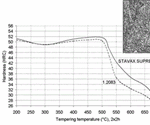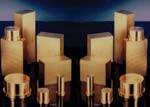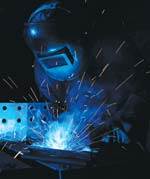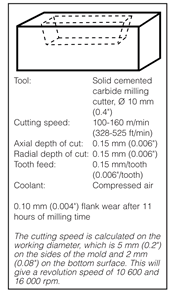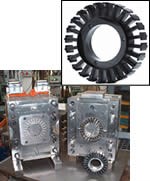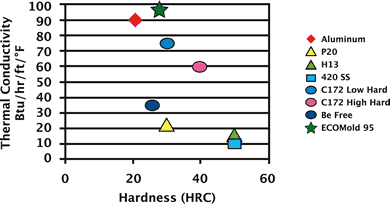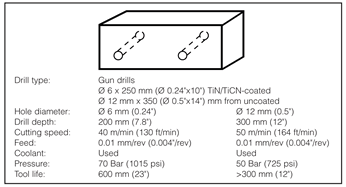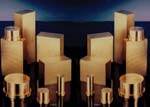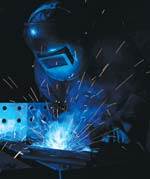Cost Savings for Mold Materials: Consider the Details
Ways to reduce costs that are not related to the price per pound of the mold material.
Choosing the right tooling material for plastic molding is becoming ever more difficult. In light of intense competition, as well as the cost of raw materials, which is driving the price of materials for molds up, it becomes increasingly more important to be selective in the choice of mold materials. There are things that can be done to help the moldmaker make the best selections for the application at hand, and these things are not simply looking at the price per pound.
But in order to do this, the moldmaker must consider other factors. This starts at the beginning of the moldmaking cycle, as the part to be manufactured is being proposed. The major areas to be considered in a mold design include:
- Size and complexity of the part or mold
- Production quantity required
- Type of plastic molding material required and its impact on the molding environment
- Mechanical requirements for the mold
- Physical property requirements for the mold (thermal conductivity, stiffness, thermal expansion)
- Stability requirement of mold during operation
- Assembly issues (mating material criteria, coatability)
- Design features (sharp corners, thin sections, sealing methods)
- Surface condition requirements (polishing, texturing demands)
- Manufacturing methods (electro dis-charge machining, hard milling)
Cost savings can occur in all these areas, but for this discussion four areas of alloys will be addressed:
- New high hardness matrix alloys
- Thermally conductive alloys
- Corrosion resistant materials
- Prehardened alloys
In each case, the cost of the mold material is significantly outweighed by the benefits these alloys bring.
1. High Hardness Matrix Alloys
In an exciting development for mold materials, there are now tool steel grades available that can replace S7, H13 and with coating replace A2, D2 and M2 types where wear resistance is required. But the advantage that these grades bring is that they can be used from 50 HRC up to 62 HRC, and are weldable, polishable to high levels, texturable and are coatable when even higher wear resistance is required.
Very tough grades, these materials also provide an added advantage that thermal conductivity exceeds that of H13, hence cycle times can be reduced. These grades replace past cold work grades that could only achieve their mechanical properties by low temperature tempers, which did not permit good weldability, nitriding or PVD coating above 400oF. Their high polishability and texturability is due to the excellent uniformity of the matrix from the use of high technology remelting processes.
An example of this is shown in Figure 1. An injection mold insert made of Polyamide plus 30 percent glass fiber, was manufactured from a chromium-molybdenum-vanadium alloyed tool steel. At 54-56 HRC, it has been running for over 7,700 pieces and is still running well. Premium H13 at 50-52 HRC began to wear and plastically deform at 6,000 pieces.
2. Thermally Conductive Alloys
Copper alloys have been available for several years to address the need for cycle time reduction and part reproducibility, and have been used particularly for cores where plastic residing times are highest. Copper-beryllium alloys are available in hardness ranges of 30-40 HRC. In addition, there is a copper-nickel alloy that can achieve hardness of 30 HRC, which is in the range of a typical P20. The advantage this grade brings is that its thermal conductivity exceeds that of other copper alloys in this hardness range, and also that of aluminum. This grade also is antigalling and corrosion resistant (see Figure 2).
3. Design and Stainless Alloys
It is time to reconsider stainless alloys. There are new stainless alloys whose benefits are clear: high polishability, with toughness levels in the range of Premium H13, up to 50-52 HRC. The fact that these alloys will maintain their corrosion resistance with minimal need for rework or repolishing over the life of the mold, and still provide a durable, high mechanical strength mold, is worth careful consideration.
One area which has limited the life of stainless molds in the past has been the use of tapered pipe plugs. Heat treatment limitations, machining issues with devel-oping the threads, stresses generated in the threads following torquing, along with the corrosive conditions of dead zones—which create pitting attack on the stainless—can lead to cracking in these regions. New stainless alloys can minimize susceptibility to this along with plug designs that are available to handle hydraulic sealing issues without machining threads into the mold material.
4. Prehardened Mold Materials
Looking away from the steel cost to manufacturing technique, we now see the development of machining practices, which permit the customer to use grades that are prehardened to higher hardness ranges. It is now possible to machine grades like H13 at hardness levels in the range of 44-46 HRC, and in many cases even harder. The advantage this brings is that the steel can be prehardened, in a method that gives excellent properties because the cooling rates can be faster when less detail is in the mold, and cracking susceptibility is less. The integrity of the steel increases, while the need for rough machining, stress relieving and prefinish machining is eliminated. This saves time and money, when usually at the stage when heat treatment is performed, time constraints are high. With these time constraints, corners get cut and heat treatment is not always done to optimize the property of the steel. Tempers may not all get done, and cooling rates are slowed down to permit less stock to be left on, because the moldmaker has less time to remove the extra stock needed for the movement that will take place from a good, rapid quench.
Some examples of how to machine a hardened H13 are given in Figures 3, 4 and 5.
Conclusion
There are many ways to reduce cost that are not related to the price per pound of the mold material. With the ultimate goal to provide the customer what they need in terms of part integrity and reliability, manufacturing a mold that will provide all of these things in a reasonable way requires a thorough review of the design criteria, manufacturing processes and production demands. New materials and methods are available that were not there the last time the mold was made, that can help minimize the overall cost of the mold.
Related Content
The Ins and Outs of Hot Runner Temperature Control
A training checklist that explains the why and how of proper hot runner temperature control and system management.
Read MoreHow to Eliminate Chatter
Here are techniques commonly used to combat chatter and guidelines to establish a foundation for optimizing the moldmaking process.
Read MoreMold Design Review: The Complete Checklist
Gerardo (Jerry) Miranda III, former global tooling manager for Oakley sunglasses, reshares his complete mold design checklist, an essential part of the product time and cost-to-market process.
Read MoreWhat You Should Consider When Purchasing Modified P20 Steel
When buying P20 steels that have been modified, moldmakers must be aware of the variations and key issues that affect delivery, cost and lead times.
Read MoreRead Next
Breaking the H-13 Stereotype For the Common Mold
A look at the new grades and steel making practices that are available to address the day-to-day issues that occur in the operation of a mold.
Read MoreIt's a Material World
Strength, hardness and machinability are the common buzzwords that come into play when examining the new materials on the market.
Read MoreImprove Shop Efficiencies with The Right Material Supplier
What to look for when choosing a single source for your product needs.
Read More
